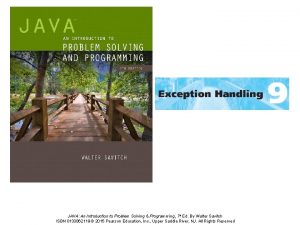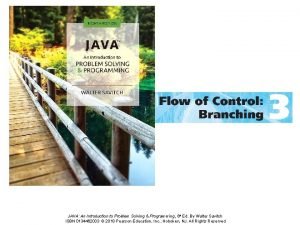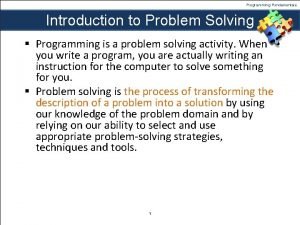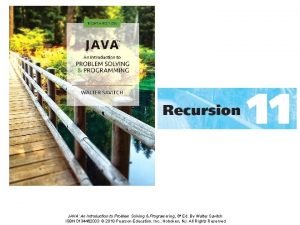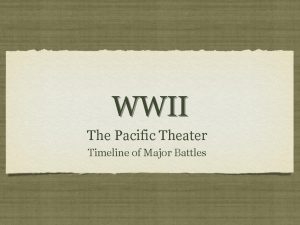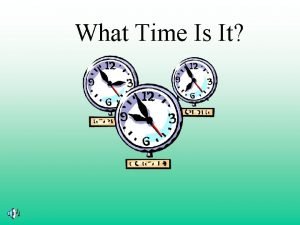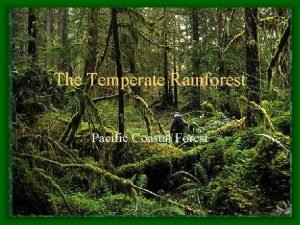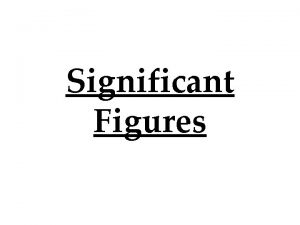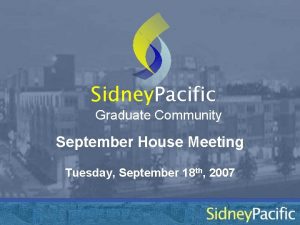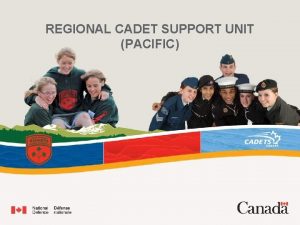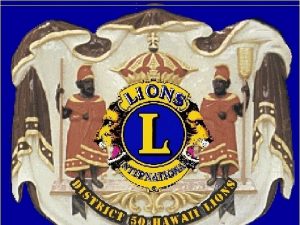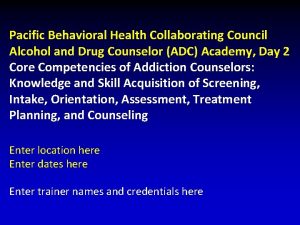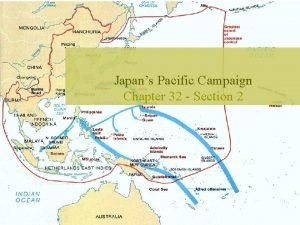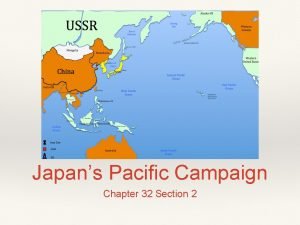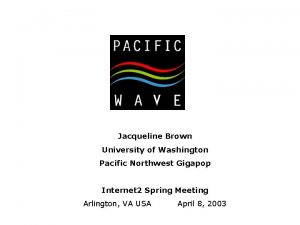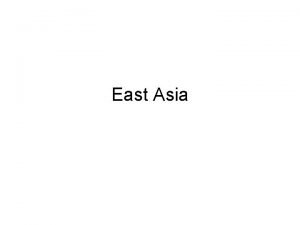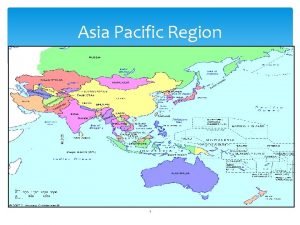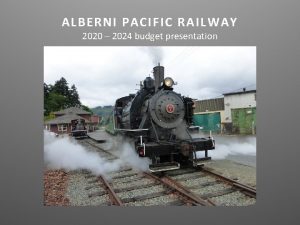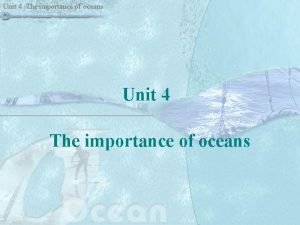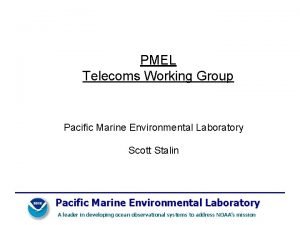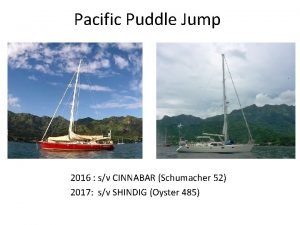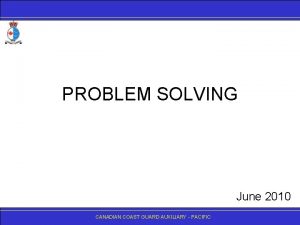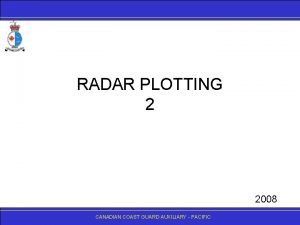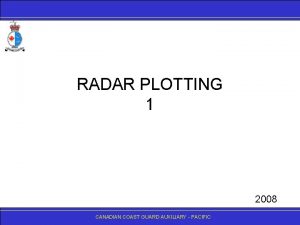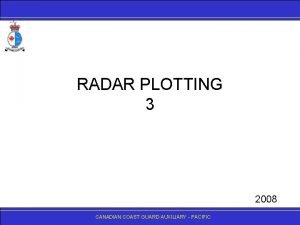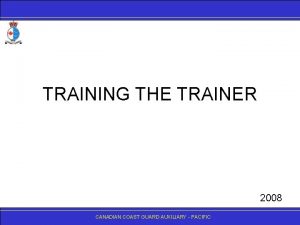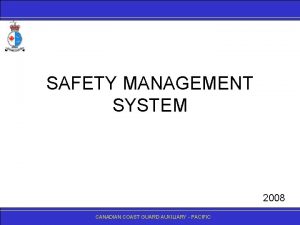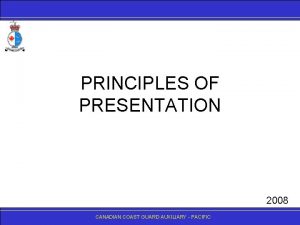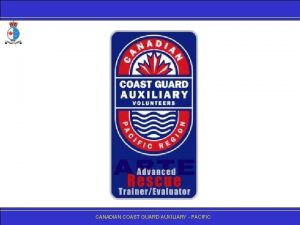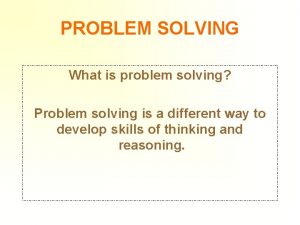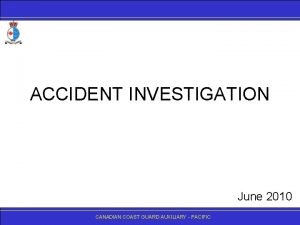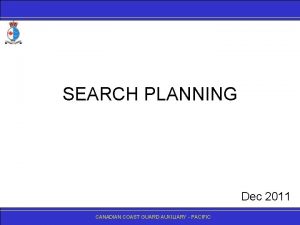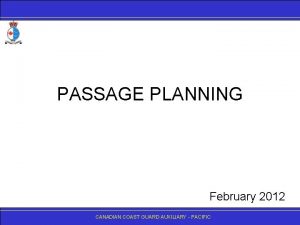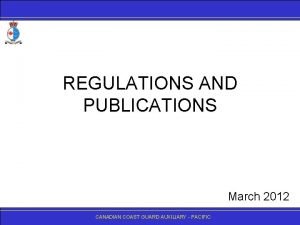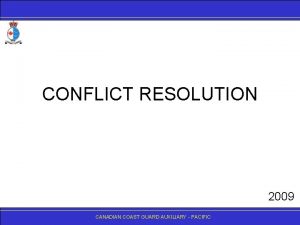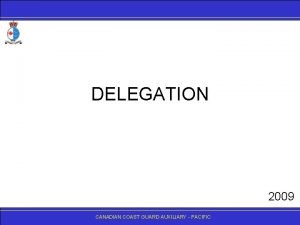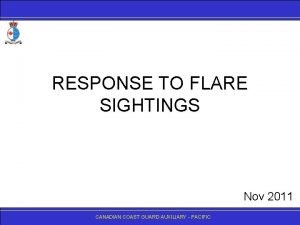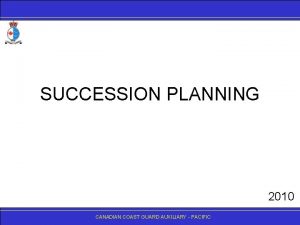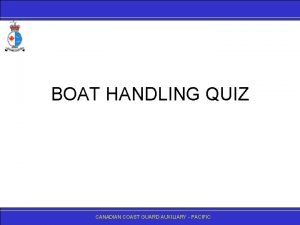PROBLEM SOLVING 2008 CANADIANCOASTGUARDAUXILIARY PACIFIC Introduction Problem solving

PROBLEM SOLVING 2008 CANADIANCOASTGUARDAUXILIARY- -PACIFIC

Introduction • Problem solving is a part of everyday life, - as problem solving becomes more involved, there are further skills needed, such as facilitation and negotiation. CANADIAN COAST GUARD AUXILIARY - PACIFIC

Introduction • The volunteers of the CCGA-P will likely face problem solving on missions. • This is best achieved using all members of the crew. • Use of Stop, Assess, Plan by the coxswain and crew to elicit the necessary thoughts and feedback to assist the coxswain come up with the best and safest solution. CANADIAN COAST GUARD AUXILIARY - PACIFIC

Introduction • What is a ‘problem’? – the difference between what is, and what that might or should be. • What is ‘problem solving’? – "an individual or collaborative process composed of two different skills: (1) to analyse a situation accurately, & (2) to make a good decision based on that analysis. " CANADIAN COAST GUARD AUXILIARY - PACIFIC

Purpose • To define the 7 steps of the Problem Solving Process • To describe some of the Road Blocks to problem solving CANADIAN COAST GUARD AUXILIARY - PACIFIC

Problem Solving Process 1. Recognize And Define The Problem 2. Gather Facts And Make Assumptions 3. Define End States And Establish Criteria 4. Develop Possible Solutions 5. Analyze And Compare Possible Solutions 6. Select And Implement the Best Solution 7. Analyze Solution For Effectiveness CANADIAN COAST GUARD AUXILIARY - PACIFIC

1. Recognise and Define the Problem CANADIAN COAST GUARD AUXILIARY - PACIFIC

1. Recognise and Define the Problem • What is the problem? • Is it likely you understand the full scope of the problem? • What must be done? CANADIAN COAST GUARD AUXILIARY - PACIFIC

2. Gather Facts and Make Assumptions CANADIAN COAST GUARD AUXILIARY - PACIFIC

2. Gather Facts and Make Assumptions • Facts- Statements about the problem known to be true or there is positive proof. • Assumptions- Statement used to replace necessary but missing or unknown facts. CANADIAN COAST GUARD AUXILIARY - PACIFIC

2. Gather Facts and Make Assumptions 1. Start with what you know. 2. Decide what information is missing, and where assumptions will have to be made 3. Gather information on the problem. 4. Define the problem. CANADIAN COAST GUARD AUXILIARY - PACIFIC

2. Gather Facts and Make Assumptions • Why analyse the problem? – to better identify what the problem or issue is. – to understand what is at the heart of a problem. – to determine the barriers and resources associated with addressing the problem. – to develop the best action steps for addressing the problem. CANADIAN COAST GUARD AUXILIARY - PACIFIC

2. Gather Facts and Make Assumptions • The group should be led through a process of understanding every aspect of the problem by answering questions such as: WHAT is the problem? WHY does the problem exist? WHO is causing the problem, and who is affected by it? WHEN did the problem first occur, or when did it become significant? Is this a new problem or an old one? CANADIAN COAST GUARD AUXILIARY - PACIFIC

2. Gather Facts and Make Assumptions HOW MUCH, or to what extent, is this problem occurring? How many people are affected by the problem? How significant is it? CANADIAN COAST GUARD AUXILIARY - PACIFIC

2. Gather Facts and Make Assumptions • Some criteria to help your decision. The problem: a. occurs frequently. (frequency) b. has lasted for a while. (duration) c. affects many people. (scope, or range) d. is disturbing, and possibly intense -disruptive of personal or community life. (severity) e. deprives people of legal or moral rights. (legality) f. is perceived as a problem. (perception) CANADIAN COAST GUARD AUXILIARY - PACIFIC

2. Gather Facts and Make Assumptions • Also consider: Feasability? Are you best placed to solve it? Any possible negative impacts? CANADIAN COAST GUARD AUXILIARY - PACIFIC

2. Gather Facts and Make Assumptions • List the problems being faced, & to what extent they meet the criteria (frequency, duration etc). • It's hard to assign values for something like this, because for each situation, one of the criteria may strongly outweigh the others. • However, just having all of the information in front of the group can help the decision making process. CANADIAN COAST GUARD AUXILIARY - PACIFIC

3. Define End States and Define Criteria CANADIAN COAST GUARD AUXILIARY - PACIFIC

3. Define End States and Define Criteria • End States - identify where you want to be at the end of the process - the goals and objectives • Criteria - define how you will judge a successful outcome – Selection - used to gather valid solution – Evaluation - used to compare solutions CANADIAN COAST GUARD AUXILIARY - PACIFIC

4. Develop Possible Solutions CANADIAN COAST GUARD AUXILIARY - PACIFIC

4. Develop Possible Solutions • Strategies may include: – Round the room (verbal) – Round the room (written) – Idea writing – Brainstorming – Mapping CANADIAN COAST GUARD AUXILIARY - PACIFIC

5. Analyse and Compare Possible Solutions CANADIAN COAST GUARD AUXILIARY - PACIFIC

5. Analyse and Compare Possible Solutions • Use predetermined evaluation criteria 1. For each idea, list or say: a. What you like about it b. What you don't like it c. What the side effects might be CANADIAN COAST GUARD AUXILIARY - PACIFIC

5. Analyse and Compare Possible Solutions 2. Ask the following questions: a. Is it practical? b. Is it effective? c. Is it cost effective? d. Will it be easy to put into practice? e. Will it be accepted by everyone involved? f. Is it consistent with other things done by the group? CANADIAN COAST GUARD AUXILIARY - PACIFIC

5. Analyse and Compare Possible Solutions 3. Modify the solution you are looking at, if suggestions have come up that can improve it. • Go back to “Facts and Assumptions” or “Establish Criteria” if necessary CANADIAN COAST GUARD AUXILIARY - PACIFIC

6. Select and Implement the Best Solution CANADIAN COAST GUARD AUXILIARY - PACIFIC

6. Select and Implement the Best Solution • Make the decision – There are different methods how to make a decision, dependant upon the situation and the problem: 1. Have the senior person (station leader / coxswain) decide, & then announce the decision to the group (crew) CANADIAN COAST GUARD AUXILIARY - PACIFIC

6. Select and Implement the Best Solution 2. Gather input from the group (crew) & then have the senior person (station leader /coxswain) decide. 3. Vote • Where time is available, try to build consensus among everyone at the meeting • Acceptable, Feasible, and Suitable CANADIAN COAST GUARD AUXILIARY - PACIFIC

6. Select and Implement the Best Solution 1. Is the solution acceptable? Does the solution cause other problems? If a casualty has flooded but flooding is not progressing, and the vessel is stable, but the flooded compartment has a lot of oil in it, is it acceptable to pump that oil over the side? CANADIAN COAST GUARD AUXILIARY - PACIFIC

6. Select and Implement the Best Solution 2. Is the solution feasible? Are you able to do it with the resources available? Does your pump have the capacity to contain the flooding? CANADIAN COAST GUARD AUXILIARY - PACIFIC

6. Select and Implement the Best Solution 3. Is the solution suitable? Does the solution actually solve the problem? Is blocking all the designed hull penetrations a suitable solution to stop a vessel sinking, if there is bottom damage? CANADIAN COAST GUARD AUXILIARY - PACIFIC

7. Analyse Solution for Effectiveness CANADIAN COAST GUARD AUXILIARY - PACIFIC

7. Analyse Solution for Effectiveness • Is the problem being solved slowly or quickly It may take time • If the solution works, pass it on! CANADIAN COAST GUARD AUXILIARY - PACIFIC

Collaborative Problem Solving • Why ‘collaborative’ problem solving? - problems and challenges faced as members of our organisations often affect everyone in the group - when working with more than just a few people, solving a problem with a set process becomes more manageable. - it raises ownership of and commitment to the solution, and increases group satisfaction. CANADIAN COAST GUARD AUXILIARY - PACIFIC

Road Blocks to Problem Solving CANADIAN COAST GUARD AUXILIARY - PACIFIC

Road Blocks to Problem Solving 1 • Fear Of Failure • Tunnel Vision • Over Seriousness • Over Certainty • Binding Customs • Fear Of The Unknown • Command Pressure CANADIAN COAST GUARD AUXILIARY - PACIFIC

Road Blocks to Problem Solving 2 • Failure to properly identify the problem • Failure to talk with others who have dealt with the problem • Lack of adequate information to make valid assumptions • Not identifying all of the players • Not specifying the desired end state CANADIAN COAST GUARD AUXILIARY - PACIFIC

The Next Step…. . Having worked through this process, the obvious next step is to implement the chosen solution……and of course, to evaluate it! Good Luck! CANADIAN COAST GUARD AUXILIARY - PACIFIC

Conclusion • The goal is to have high-quality, acceptable decisions made on missions and in training situations. • The Problem Solving Process helps coxswains ands crews face complex problems in situations where information might be limited. CANADIAN COAST GUARD AUXILIARY - PACIFIC
- Slides: 39

